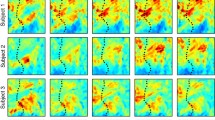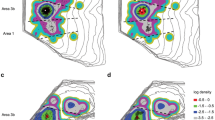Abstract
Fast adaptations in the functional organization of primary sensory cortex are generally assumed to result from changes of network connectivity. However, the effects of intrinsic neuronal excitability alterations due to the activation of neighboring cortical representational zones, which might as well account for the changes of cortical representative maps, have been paid little attention to. In a recent experiment (Braun et al. 2000b) we showed by neuromagnetic source imaging that random or fixed sequence stimulation of three digits of both hands led to stimulation-timing-induced changes in primary somatosensory (SI) cortical maps. The distance between the cortical representation of thumb and middle finger became significantly shorter during the fixed sequence stimulation. The analysis on the time course of the cortical map changes revealed that these reorganizations occurred within minutes and were fully reversible. The previously reported results were interpreted as the involvement of a superordinate center responsible for detecting and activating the appropriate maps. Here we present an alternative parsimonious explanation that is supported by a computational model. Based on the experimental evidence, we developed a simple model that took intrinsic neuronal excitability together with subthreshold activation into account and assumed partial cortical overlap of the representational zones of neighboring digits. Furthermore, in the model the neuronal excitability decayed slowly with respect to the stimulation frequency. The observed cortical map changes in the experiment could be reproduced by the two-layer feed-forward computational network. Our model thus suggests that the dynamic shifts of cortical maps can be explained by the state and time course of intrinsic neuronal excitability and subthreshold activation, without involving changes in network connectivity.
Similar content being viewed by others
References
Allard T, Clark SA, Jenkins WM, Merzenich MM (1991) Reorganization of somatosensory area 3b representations in adult owl monkeys after digital syndactyly. J Neurophysiol 66:1048–1058
Baumgartner C, Doppelbauer A, Sutherling WW, Zeitlhofer J, Lindinger G, Lind C, Deecke L (1991) Human somatosensory cortical finger representation as studied by combined neuromagnetic and neuroelectric measurements. Neurosci Lett 134:103–108
Birbaumer N, Lutzenberger W, Montoya P, Larbig W, Unertl K, Topfner S, Grodd W, Taub E, Flor H (1997) Effects of regional anesthesia on phantom limb pain are mirrored in changes in cortical reorganization. J Neurosci 17:5503–5508
Borsook D, Becerra L, Fishman S, Edwards A, Jennings CL, Stojanovic M, Papinicolas L, Ramachandran VS, Gonzalez RG, Breiter H (1998) Acute plasticity in the human somatosensory cortex following amputation. Neuroreport 9:1013–1017
Braun C, Schweizer R, Elbert T, Birbaumer N, Taub E (2000a) Differential activation in somatosensory cortex for different discrimination tasks. J Neurosci 20:446–450
Braun C, Wilms A, Schweizer R, Godde B, Preissl H, Birbaumer N (2000b) Activity patterns of human somatosensory cortex adapt dynamically to stimulus properties. Neuroreport 11:2977–2980
Calford MB, Tweedale R (1991) Acute changes in cutaneous receptive fields in primary somatosensory cortex after digit denervation in adult flying fox. J Neurophysiol 65:178–187
Debanne D, Daoudal G, Sourdet V, Russier M (2003) Brain plasticity and ion channels. J Physiol Paris 97:403–414
Dinse HR, Ragert P, Pleger B, Schwenkreis P, Tegenthoff M (2003) Pharmacological modulation of perceptual learning and associated cortical reorganization. Science 301:91–94
Egorov AV, Hamam BN, Fransen E, Hasselmo ME, Alonso AA (2002) Graded persistent activity in entorhinal cortex neurons. Nature 420:173–178
Flor H, Elbert T, Knecht S, Wienbruch C, Pantev C, Birbaumer N, Larbig W, Taub E (1995) Phantom-limb pain as a perceptual correlate of cortical reorganization following arm amputation. Nature 375:482–484
Garraghty PE, LaChica EA, Kaas JH (1991) Injury-induced reorganization of somatosensory cortex is accompanied by reductions in GABA staining. Somatosens Mot Res 8:347–354
Godde B, Hilger T, von Seelen W, Berkefeld T, Dinse HR (1995) Optical imaging of rat somatosensory cortex reveals representational overlap as topographic principle. Neuroreport 7:24–28
Godde B, Spengler F, Dinse HR (1996) Associative pairing of tactile stimulation induces somatosensory cortical reorganization in rats and humans. Neuroreport 8:281–285
Jacobs KM, Donoghue JP (1991) Reshaping the cortical motor map by unmasking latent intracortical connections. Science 251:944–947
Merzenich MM, Kaas JH, Wall J, Nelson RJ, Sur M, Felleman D (1983) Topographic reorganization of somatosensory cortical areas 3b and 1 in adult monkeys following restricted deafferentation. Neuroscience 8:33–55
Merzenich MM, Nelson RJ, Stryker MP, Cynader MS, Schoppmann A, Zook JM (1984) Somatosensory cortical map changes following digit amputation in adult monkeys. J Comp Neurol 224:591–605
Moore CI, Nelson SB (1998) Spatio-temporal subthreshold receptive fields in the vibrissa representation of rat primary somatosensory cortex. J Neurophysiol 80:2882–2892
Nakamura A, Yamada T, Goto A, Kato T, Ito K, Abe Y, Kachi T, Kakigi R (1998) Somatosensory homunculus as drawn by MEG. Neuroimage 7:377–386
Nelson RJ, Sur M, Felleman DJ, Kaas JH (1980) Representations of the body surface in postcentral parietal cortex of Macaca fascicularis. J Comp Neurol 192:611–643
Ragert P, Becker M, Tegenthoff M, Pleger B, Dinse HR (2004) Sustained increase of somatosensory cortex excitability by 5 Hz repetitive transcranial magnetic stimulation studied by paired median nerve stimulation in humans. Neurosci Lett 356:91–94
Simons DJ (1985) Temporal and spatial integration in the rat SI vibrissa cortex. J Neurophysiol 54:615–635
Sterr A, Muller MM, Elbert T, Rockstroh B, Pantev C, Taub E (1998) Perceptual correlates of changes in cortical representation of fingers in blind multifinger Braille readers. J Neurosci 18:4417–4423
Zhang W, Linden DJ (2003) The other side of the engram: experience-driven changes in neuronal intrinsic excitability. Nat Rev Neurosci 4:885–900
Author information
Authors and Affiliations
Corresponding author
Rights and permissions
About this article
Cite this article
Li Hegner, Y., Wiech, K., Preissl, H. et al. Do cortical maps depend on the timing of sensory input? Experimental evidence and computational model. Biol Cybern 94, 110–117 (2006). https://doi.org/10.1007/s00422-005-0024-x
Received:
Accepted:
Published:
Issue Date:
DOI: https://doi.org/10.1007/s00422-005-0024-x




